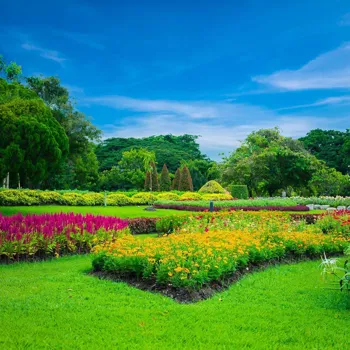Unveiling the Enchanting World of Mughal Gardens - Discover the Magic of Beauty, History, and Grandeur in Every Corner!
India, a land steeped in history and brimming with architectural marvels, boasts a unique
legacy from the Mughal era: the breathtaking Mughal Gardens.
These gardens are not just patches of greenery; they are meticulously planned paradises, reflecting a fusion of Persian and Indian aesthetics, embodying the Mughal emperors' love for beauty, order, and tranquility.
From the iconic Shalimar Bagh in Srinagar to the serene Pinjore Garden near Chandigarh, these gardens offer a sensory feast, a respite from the hustle of modern life, and a journey back in time.
If you're wondering what makes these gardens so special and why they deserve a spot on your travel itinerary, look no further. This guide will unveil the seven key features that make Mughal Gardens an absolute must-visit for anyone seeking beauty, history, and a touch of royal grandeur.
Get ready to be transported to a world of fragrant blooms, cascading fountains, and meticulously crafted landscapes!
Mughal Gardens symbolize life's journey with rich cultural significance
The Mughal Gardens are far more than just pretty flowers and neatly trimmed lawns, and they showcase deep symbolism. The careful placement of water channels represents life's journey, originating from a spring which depicts the beginning of all things.
The arrangement of the gardens into squares, a design principle called "charbagh", signifies the four gardens of Paradise as described in the Quran. This religious connection adds a unique spiritual aspect to the gardens, inviting contemplation and peace.
You will find that every element of the garden, from the choice of plants to the placement of pavilions, has a story to tell, waiting for you to discover the rich cultural and religious values that were so dear to the Mughal rulers.
Mughal Gardens: Ingenious water systems enhance beauty and function
Water is the soul of any Mughal Garden, and the intricate systems designed to showcase it are a marvel of engineering. The most prominent feature is the network of canals and fountains which uses gravity to move water through the garden.
These water channels, often made of marble and adorned with decorative tiles, not only provide irrigation but also create a soothing ambiance through their gentle flow.
The fountains, strategically placed to maximize their visual and auditory impact, create a playful dance of light and water, adding to the garden's charm. Many gardens feature stepped terraces with waterfalls cascading down, adding depth and movement to the landscape.
This creative use of water not only enhances the aesthetic appeal but also helps cool the air, making the gardens a pleasant escape from the summer heat.
Mughal emperors crafted exquisite gardens with symbolic, fragrant plants
The Mughal emperors, known for their refined taste, gave special attention to the selection of plants and flowers. The gardens were meticulously planned to showcase a variety of colors, textures, and fragrances throughout the year.

Roses, tulips, lilies, and irises were among the favorite blooms, creating a vibrant palette that changed with the seasons. Fruit trees, such as mangoes, almonds, and pomegranates, were also integral parts of the design, providing shade and sustenance.
Fragrant herbs and flowering shrubs completed the sensory experience, filling the air with delightful scents. The selection of plants was not purely aesthetic, as certain plants also held symbolic meaning.
Cypress trees, for example, represented immortality, while flowering plants symbolized beauty and vitality. The rich choice of plants adds to the garden's beauty.
Mughal gardens blend Persian and Indian styles in design
Mughal Gardens usually incorporate architectural elements that highlight the design and increase the utility of the space. Pavilions or "baradaris", which mean "having twelve doors", are open-sided structures that offer shaded seating and panoramic views of the surroundings.
These elevated platforms served as gathering places for the royal family and their guests, providing a perfect spot for relaxation and appreciating the garden's beauty.
The architectural designs of the buildings, which showcase a fusion of Persian and Indian styles, contribute to the garden's aesthetic appeal. The use of arches, domes, and intricate carvings enhanced the garden's royal feel.
The pavilions often feature decorative elements, such as marble inlays and intricate geometric patterns, reflecting the grandeur of the Mughal empire.
Mughal Charbagh layout symbolizes harmony with four gardens, representing paradise
The Charbagh layout, which translated means "four gardens", is a defining feature of Mughal gardens. This concept divides the garden into four equal sections by walkways or flowing bodies of water.
The symmetrical design reflects the Mughal sense of order and harmony, creating a visually pleasing and balanced space. The four sections represent the four gardens of Paradise mentioned in the Quran, symbolizing abundance and prosperity.
In the classical Charbagh layout, a pavilion or tomb is commonly located at the center of the intersection, serving as a focal point for the entire garden. The careful planning of the Charbagh layout helps to create a pleasing environment for any visitor or observer.
The layout directs movement through the space.
Mughal Gardens: Sophisticated design with depth, order, and harmony, creating visual appeal
The Mughal Gardens feature sophisticated and aesthetically pleasing design, that goes beyond just symmetrical patterns. They incorporate methods that add depth, perspective, and the illusion of greater space.
Terraced gardens, with different levels connected by stairways and ramps, create a sense of visual interest and invite exploration. The strategic placement of trees and shrubs can create a sense of depth, making the garden appear larger than it actually is.
Geometric patterns, used in the walkways, water channels, and flowerbeds, create a sense of order and harmony that directs the eye and helps define the space.
The careful consideration of light and shadow further enhances the garden's visual appeal, creating a dynamic experience that changes throughout the day. This sophistication in planning ensures that the gardens remain beautiful, and places worth visiting.










